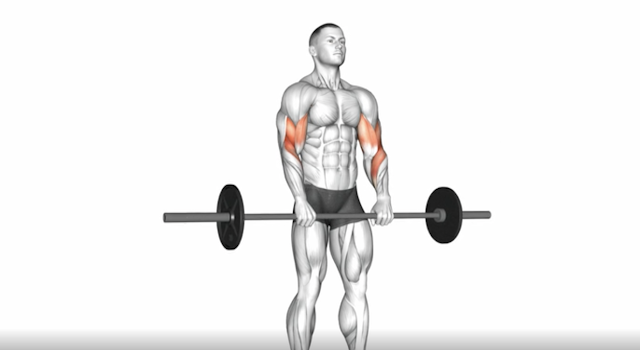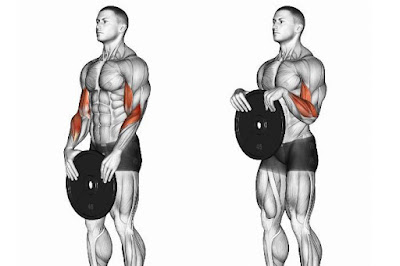
What is a reverse grip bicep curl?
Reverse grip bicep curls are a resistance exercise that targets the biceps and forearms. It is performed with a barbell or cable machine with a bar attachment.
The movement is similar to a standard curl except that it uses an overhand grip as opposed to an underhand grip.
The reverse grip bicep curl is a great exercise for developing your outer bicep head as well as your forearms. This outer bicep exercise needs a bit of easing in to if you do not already train your forearms as the DOMS can be very painful.
The reverse grip bicep curls are ideal for super-setting with an exercise that targets the inner head such as a close grip rope curl. It can only really be performed correctly with a light weight, so adding it in as a secondary set to pre-fatigued biceps is ideal.
How to perform a reverse grip bicep curl.
The reverse grip bicep curl can be performed on the straight bar but is usually easier on an EZ bar as it allows the wrists to be at a neutral angle.
As with a regular barbell curl, hold the weight with your arms at shoulder width over the top of the bar, using your thumbs to secure it.
Without moving your upper arms, curl the bar up as far as it will go and hold. Squeeze the outer bicep for a couple of seconds and then lower the weight in a slow, controlled motion.
It is important to keep your wrists rigid to develop the forearm so this exercise can only be performed properly with a relatively light weight.
It is better to aim for high reps or tag it on as the second superset with a heavy inner bicep exercise.
Variations of a reverse grip bicep curl.
As previously mentioned, you can use a straight bar or EZ bar for a reverse grip bicep curl. This can be on a barbell or attached to a cable on a machine.
Dumbbells can also be used, but it will be harder to stabilize them in the reverse position.
Reverse grip curl versus regular grip curl
There are two main types of bicep curls: reverse grip and regular grip. The difference between the two is the position of your palms during the exercise. With a regular grip, your palms face forward, while with a reverse grip they face backwards.
So, which is better? It depends on your goals. If you want to build bigger biceps, then reverse grip bicep curls are the way to go. This is because they place more emphasis on the inner head of the biceps, which is responsible for growth.
If, on the other hand, you're looking to improve your strength and definition, then regular grip bicep curls are better. This is because they work both the inner and outer heads of the biceps equally.
Ultimately, it comes down to what you want to achieve with your training. It is a good idea to include both in your training if you are seeking hypertrophy.
Benefits of the reverse grip bicep curl
The reverse grip curl is a great way to target your biceps and build upper body strength. This exercise is simple to do and doesn't require any special equipment, making it a great choice for a home workout. Plus, the reverse grip curl can be done with either dumbbells or a barbell, so you can adjust the weight to suit your fitness level.
There are many benefits to doing the reverse grip curl, including:
1. Increased bicep activation - The reverse grip puts your biceps in a better position to work, meaning you'll get more out of each rep.
2. Greater range of motion - This exercise allows you to lower the weight further than with a traditional curl, resulting in a greater range of motion and more muscle growth.
3. Improved grip strength - The reverse grip forces you to use your fingers and wrists more, leading to increased grip strength over time.
4. Enhanced mind-muscle connection - Because the reverse grip is less common than the traditional curl, it can help you focus more on your biceps and connect with them better during your workout.
Reverse curl on the forearms
Reverse grip curls are not only great for building bigger biceps, they are also a great way of developing size and strength in the forearm. Adding in a mixture of hammer curls and reverse grip curls to your regular arm routine will help you to achieve great gains in the forearms and give a better aesthetic to the arms.
Alternatives to reverse grip barbell curl
Alternatives to the reverse grip barbell curl include alternating standing barbell curls, dumbbell seated curls, and single-arm cable curls. The latter exercise can be performed with a rope or a straight bar attachment.
If you struggle to perform a reverse grip curl with a straight bar, try using an EZ bar, some fat grips or even just a single weight plate.
Using a single weight plate for your reverse grip curls allows you to turn your palms towards each other slightly and this can take away any discomfort.
Conclusion
Reverse grip bicep curls are a great exercise for targeting the biceps. They can be done with dumbbells, barbells, or cables, and they're a great addition to any arm workout. If you're looking to add some variety to your bicep training, give reverse grip curls a try!
We hope that you have found this article helpful and that we have answered the question - what is a reverse grip bicep curl?
If you are looking for maximum hypertrophy from your training, check out our free HyperGrowth workout split by clicking on this link.
What is a reverse grip bicep curl alternative?
The standing bicep curl is similar to a reverse grip curl but it is performed with palms facing upwards. This grip takes focus away from the forearms and isolates the bicep muscle. Although you can train with a heavier load when using a standard grip, there is little benefit to forearm development.
Rope hammer curls are probably the best alternative to reverse grip curls. They still target the biceps but also activate the forearms to a large degree making them a great, al round arm exercise.
Incline dumbbell curls are another exercise that are great for bicep development but do not really activate the forearms to a noticeable degree. They should be a part of any arm workout but not as a forearm movement.
Free Trainig Programmes
Gymenix offers a selection of free training programs to suit all abilities and goals. Click on the links below for FREE access.



.png)



